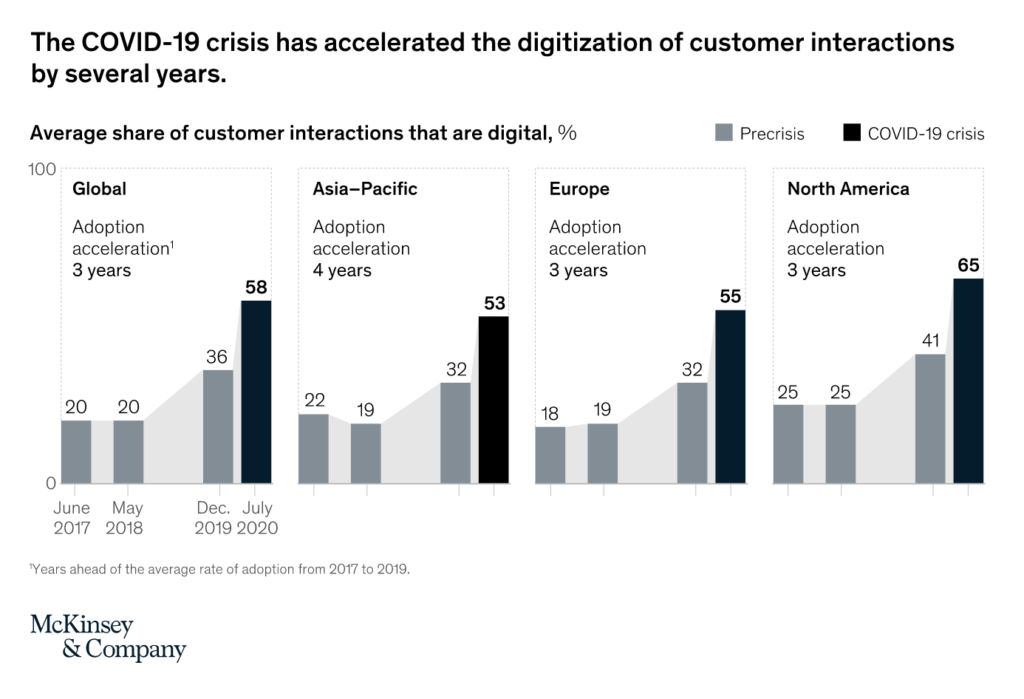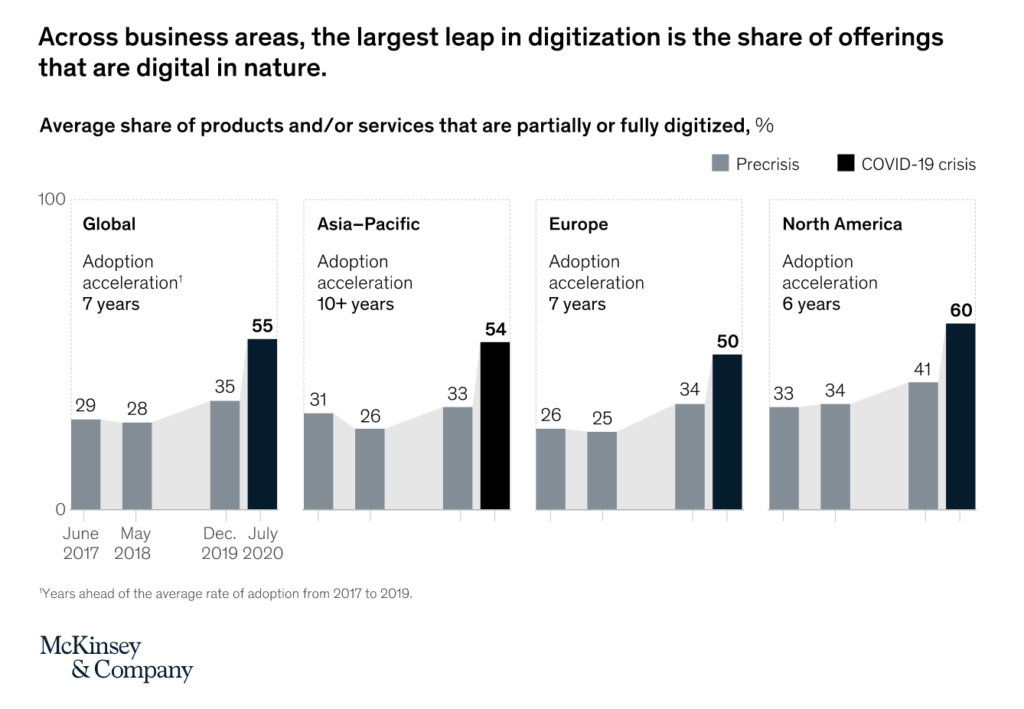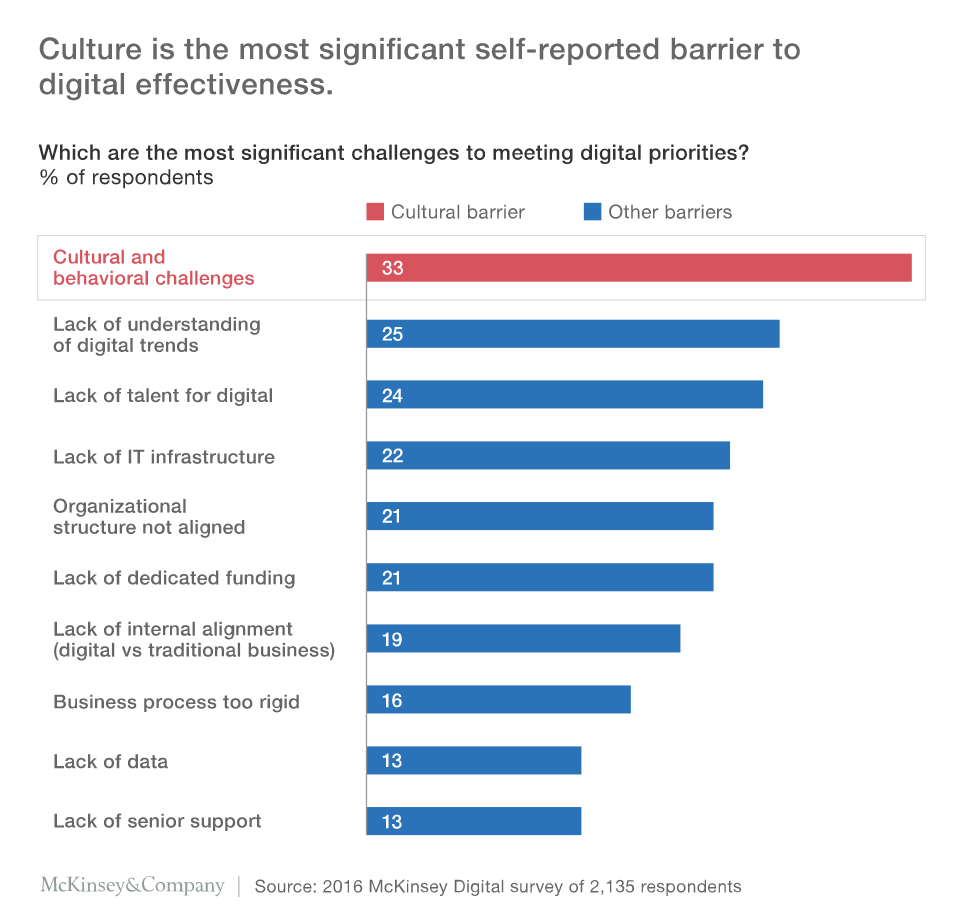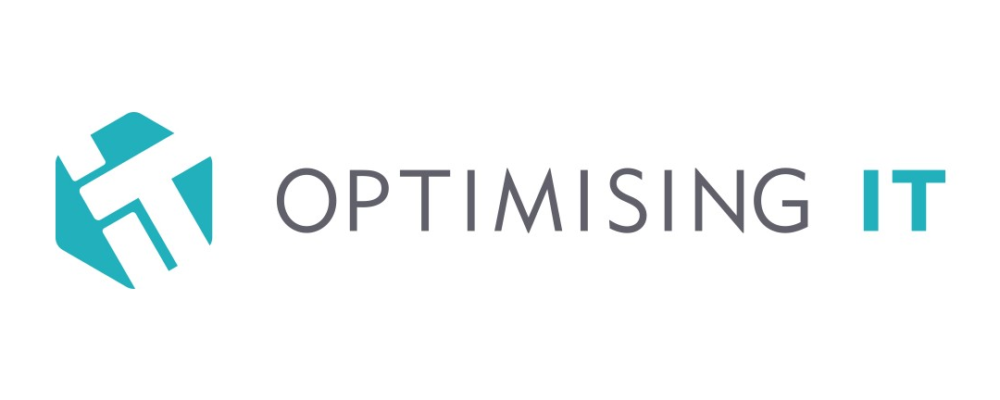In this guide to digital transformation services, we break down how new digital technologies are changing the way businesses operate and provide value to customers.
The COVID-19 pandemic has been a watershed moment for digital transformation. As lockdowns and social distancing guidelines shut down businesses and forced consumers to stay home, organisations suddenly faced the dire need to digitise their customer interactions and supply chain processes.
At Optimising IT, we believe that digital transformation is a matter of when, not if, for businesses — from small and medium enterprises (SMEs) to large multinational corporations. We’ve put together this comprehensive introduction to digital transformation, which covers:
- Its basic definition
- Steps for driving digital transformation
- Examples of digital transformation services
- Examples of successful digital transformation projects.
You can also skip to each section covered in this guide by clicking on the links below:
- COVID-19: Putting Digital at the Forefront of Business
- How Digital Technologies Protect Firms from Disruption
- What Is Digital Transformation?
- How to Drive Digital Transformation in Your Organisation
- Examples of Digital Transformation Services
- Examples of Successful Digital Transformations
COVID-19: PUTTING DIGITAL AT THE FOREFRONT OF BUSINESS
According to a 2020 McKinsey Global Survey of C-level executives and senior managers, the pandemic triggered an increase in the global share of companies’ digital customer interaction. Digital interactions grew from 36% in December 2019 to 58% in July 2020 — an acceleration equal to three years of growth.

Meanwhile, the share of digital or digitally-enabled products during the pandemic grew at an accelerated rate equal to that of an incredible seven years.

More businesses are waking up to this New Normal of operations and customer engagement. IDC’s latest Worldwide Digital Transformation Spending Guide predicts that global spending on the digital transformation of business processes, products and organisations will reach $2.8 trillion in 2025 — a compound annual growth rate (CAGR) of 16.4% over the forecast period.
Related Reading: How Businesses Can Prepare for Coronavirus
HOW DIGITAL TECHNOLOGIES PROTECT FIRMS FROM DISRUPTION
These findings are not surprising. While the coronavirus crisis presented a massive impetus for digital transformation, Industry 4.0 technologies, such as big data/data analytics and artificial intelligence (AI), have long been touted as solutions for operational improvements and enterprise-wide decision-making.
But many organisations have also now realised that digital transformation can protect their operations and supply chains from disruption.
Take the banking sector, for example, whose relationships with their customers were disrupted at the height of the pandemic.
As a KPMG report notes, “Banks, even the most territorial and branch-centric ones, are forced to encourage the use of channels that have never been their strategic priority.” Meanwhile, EY reports that financial institutions must leverage the data from their digital channels to optimise their digital response times and customer experience.
In banking and sectors that receive a deluge of customer queries day in and day out, chatbots may hold the key to driving digital transformation — at least when it comes to customer service. Juniper Research predicts that chatbots will help banks reduce their operation costs by up to $7.3 billion by 2023.
Of course, all this begs the question: What exactly is digital transformation?
WHAT IS DIGITAL TRANSFORMATION?
Digital transformation, or DX, is a catchall term that refers to any instance of digital technologies used to improve an organisation’s ability to provide value to its customers and stakeholders.
An organisation’s digital transformation isn’t just about improving processes, tasks and tools. It involves using emerging technologies to reinvent the business and its core service delivery models in ways that prioritise efficiency, speed and customer satisfaction.

Generally speaking, digital transformation leverages Industry 4.0 technologies to create a cohesive ecosystem that supports mission-critical processes and creates seamless interactions with customers. These emerging technologies include:
- AI and machine learning;
- Automation;
- Cloud computing;
- Big data or data analytics;
- And the Internet of things (IoT), among others.
Digital transformation also represents a shift in your organisation’s culture, forcing you to think about how tech will change your employees, customers, and investors’ experience. Culture and behaviours were identified as the top self-reported barrier to digital effectiveness.

While every organisation’s digital transformation roadmap is unique, there are recurring themes, such as:
- Thoughtful Planning across the Entire Organisation: Digital transformation involves everyone in the company, from members of the C-suite to interns and even external stakeholders such as suppliers and contractors. Plans to be digital-first should not be limited to your IT department or team.
- Personalised Digital Transformation Strategy: There is no one-size-fits-all approach to adopting digital technologies. The most successful digital transformations are driven by a personalised strategy specifically designed for the organisation’s value proposition, core service model, verticals and stakeholders.
- Changing the Way People Work: As mentioned earlier, digital transformations often require fundamental cultural changes within the organisation. Much of this involves empowering people to work in new ways, as seen in the surge of remote work due to lockdown orders and social distancing protocols. Digital technologies, such as project management platforms like Asana and collaboration apps like Microsoft Teams, play a vital role in establishing new working environments and practices.
Related Reading: How to Implement Remote Working: An Expert’s Tech Guide
HOW TO DRIVE DIGITAL TRANSFORMATION IN YOUR ORGANISATION
Whatever steps and tactics your roadmap may include, what’s clear is that digital transformation is key to staying competitive and growing market share. According to a 2019 report by MIT and Capgemini, 87% of the companies surveyed believe that digital transformation supports their competitive advantage.
Again, your approach to digital transformation will ultimately depend on your organisation’s specific circumstances. But there are steps and best practices that apply to any transformation initiative.
1. ALIGN YOUR DIGITAL TRANSFORMATION STRATEGY WITH YOUR BUSINESS GOALS
Every digital transformation journey should begin with the questions:
- What business outcomes do you want to achieve with digital transformation?
- How will your implementation of digital technologies benefit your customers, employees and other stakeholders?
Your IT leaders play a vital role in identifying the fundamental problem your digital transformation seeks to solve and cascading this information to the rest of your organisation. This process of establishing buy-in, particularly with other managers, is critical to overcoming cultural objections to digital transformation.
2. IT TEAMS MUST PLAY A MORE ACTIVE ROLE IN DIGITAL TRANSFORMATION
Traditionally, IT departments and third-party IT consultants serving businesses used the break/fix model — that is, they provided IT services as needed, often when something had broken down.
But this method no longer works with digital transformation. Whether you have an in-house IT team/department or depend on the services of an IT consultancy, you and your IT experts will have to work closely together to figure out how digital technology can solve your business problems.
There has to be a system of co-creation. IT specialists bring their tech know-how to the table while you and other managers offer your intimate knowledge of your customers needs. Businesses can’t demand IT to drive digital transformation for them.
3. WORK WITH THE RIGHT PARTNERS AND PROVIDERS
Most SMEs don’t have in-house IT staff, let alone a fully-staffed department. According to Capgemini, while over 80% of companies believe that digital transformation is critical to staying competitive, only 46% are developing the digital skills of their employees.
In other words, your average SME is facing a skills gap that’s holding them back from digitally transforming their business. This is where third-party IT consultants, system integrators or SaaS providers come in. And even if you do have an in-house team, you may still need a specialist’s help to achieve your digital goals.
For example, if cloud migration is part of your digital transformation strategy, your team may not have the sufficient cloud skills to move your legacy IT infrastructure to the cloud.
Many businesses are all too familiar with this problem. According to Gartner’s 2021-2023 Emerging Technology Roadmap, the lack of cloud skills is the top barrier to using cloud-based technologies for strategic use.
Bottom line? Don’t be afraid to call in some outside help when necessary. Apart from expertise, consider an IT consultancy’s track record and whether their corporate values align with yours.
4. DIGITAL TRANSFORMATION MUST BE CUSTOMER-CENTRIC
When redesigning processes and products using digital technologies, it can be easy to lose sight of why you’re implementing these changes in the first place.
Ultimately, it’s your customers that reap the rewards of digital transformation. Any changes made to your organisation using digital technology must drive positive customer outcomes.
For example, if you want to use cloud software, determine how it benefits your customers, whether it’s something to do with enhanced business continuity and disaster recovery or the smoother provisioning of online services.
If data analytics is part of your game plan, ask yourself what you intend to do with your data. For many businesses, the sudden acceleration of digital services, such as eCommerce, video streaming and cloud software (most notably for remote work), has prompted an intensified focus on data analytics. According to Gartner, it’s the top priority of 82% of chief financial officers this year.
Data analytics holds the key to understanding customer behaviours and preferences, providing insights for making better data-driven decisions that lead to better business outcomes.

5. DEVELOP EMPLOYEES’ DIGITAL SKILLS
Organisations turning to digital initiatives that align with customer needs should also ensure their employees are on board. This does two things:
- First, it ensures that employees understand the why behind your digital transformation efforts and its value to customers.
- Second, it sheds light on the need to develop their digital skills and improve their knowledge of cloud computing, automation, and AI.
This seems simple enough, but research by Hays shows that 62% of UK employers lack the digital skills necessary to meet their organisational objectives. To mitigate this shortage, employers are pouring millions of dollars into upskilling and training for digital.
For example, Amazon’s Upskilling 2025 programme will see the company dedicating $1.2 billion to provide 300,000 employees with free training and subsidised tuition. The programme includes initiatives such as the Machine Learning University (MLU), which seeks to help employees develop skills in machine learning.
EXAMPLES OF SUCCESSFUL DIGITAL TRANSFORMATIONS
BIG DATA ANALYTICS — TESCO
The UK’s largest retailer has a proud history of driving innovation through its research and development team at Tesco Labs. To keep up with continually changing consumer behaviours and drive efficiencies in its supply and logistics chains, Tesco uses real-time analytics and IoT technology for monitoring inventory movement and equipment activity. Sensors across the retailer’s network of stores continuously feed volumes of data to Tesco’s team, telling them things such as when fridges and freezes require service.
Speaking to Forbes, Vidya Laxman, Tesco head of global warehouse and analytics, explains, “We are focused on data now and realise that to get where we want to be in five years, we have to find out what we will need now and create the right infrastructure.”
AUTOMATION THROUGH CHATBOTS — BELIEVE HOUSING

believe housing, one of the largest housing associations in the northeast of England, uses chatbots to answer residents’ frequently asked questions, such as when rent is due or how to access council services.
The chatbot also provides self-service features to tenants, allowing them to access services through chat such as:
- Paying for rent
- Scheduling a repair
- Reporting antisocial behaviour.
All this happens without requiring human intervention, freeing the housing group’s contact centre team from tedious, repetitive work.
Related Reading: 6 Examples of Successful Business Transformation Projects
AUGMENTED REALITY — IKEA
The Swedish furniture giant added augmented reality (AR) to its growing list of digital tools, making the IKEA shopping experience more accessible. Using the IKEA Place app, which seeks to “change the way people buy furniture forever,” users can display lifelike images of furniture in their living spaces to see what the item looks like. They can also match it with existing decor and get a feel for the piece before committing to a purchase.
EXAMPLES OF DIGITAL TRANSFORMATION SERVICES
An ecosystem of services, consultants and software providers are critical to successful digital transformation projects. Examples of pieces to include in your toolbox include:
- Cloud Solutions: Cloud computing is the foundation of agility in the new normal of business. Your cloud capabilities will enable you to deliver flexible and on-demand access to your products and services, as well as the resources supporting these digital offerings.By setting up a cloud-first environment, your organisation can scale your IT infrastructure as you expand your business, verticals, products, services and customer base. More importantly, you can do this in a far more cost-effective manner, saving you from wasting IT resources on on-premise hardware and software.Take the time to choose the right mix of cloud hosting providers and services to accelerate your business transformation.
Related Reading: What Is The Best Cloud Storage For Business?
- Enterprise SaaS: Enterprise software as a service (SaaS) is a critical component of digital transformation due to its ability to enhance resource allocation, agility and customer satisfaction at scale.Transitioning from an on-premise enterprise resource planning (ERP) solution to a cloud-based one instantly frees up your on-premise servers. This means you no longer have to spend on housing, powering, cooling, and maintaining expensive hardware. Your business can also operate remotely, protecting you from the kind of disruption we saw at the height of COVD.You can also supplement your enterprise SaaS solution with individual SaaS products, including project management tools, communications/intranet platforms, accounting software and content creation applications paid on a subscription basis.
- Consulting and Third-Party IT Services: Consulting companies play an important role in helping short-staffed businesses launch or accelerate their digital business transformations. These firms run the gamut from agencies, managed IT service providers, managed cloud hosting and managed cyber security, among many others.
Related Reading: What Are The Benefits Of Managed IT Services?
At Optimising IT, our personalised IT consultancy services include digital transformation solutions, ranging from cloud services to Microsoft 365 licensing and support. Talk to our team to discuss which technologies can dramatically change your core service delivery models and provide more value to your customers.













